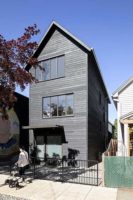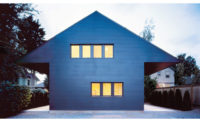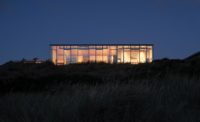In the Willamette Valley wine industry’s furious climb to global prominence, its winery architecture has rarely striven to match the terroir. Visitors swished the latest vintages, at best, in humble industrial sheds and generic storefronts—and, at worst, in faux-Tuscan knock-offs and Pacific-Northwesty lodges. But on Worden Hill Road in Dundee, Oregon, where some of the oldest vines grow, Portland-based Waechter Architecture, a 2016 Record Vanguard firm, recently completed a winery rehab for Furioso Vineyards that, in its synthesis of drama and modesty, stands with the handful of new architectural works worthy of the landscape and the pinot noir.
Additional Content:
Jump to credits & specifications
The vineyard itself is one of the valley’s most storied. It began as the Juliard Vineyards, with some of Oregon’s first and, soon, most sought-after pinot noir grapes cloned from the French Pommard and Swiss Wädenswil regions. When Washington, D.C., developer Giorgio Furioso bought the vineyard in 2014, the winery was classic valley non-architecture: a pinkish-red roadside shed that could have easily been mistaken for a village volunteer fire department.
But with his vines sweeping downward from the shed’s south side, Furioso, a onetime art professor, had high aesthetic ambitions: to create a tasting room that “nestled, like a bird’s nest” into the vineyard but that also “put you in the middle of the wine-making.” Oh, and he wanted to reuse the existing building and continue making wine in it while the new winery was being built.
Out of these seemingly irreconcilable goals and limitations, Ben Waechter and project manager Rand Pinson conjured a distinguished work of Oregon roadside winery architecture.
Waechter distilled the design into four basic parts: base, two middles, and a top. A concrete plinth covers a subterranean barrel room and provides the floor for the tasting room, a loggia-cum-crush pad where the grapes are pressed, and an adjacent “piazza.” The team wrapped the old building and a new equipment room in a 2-by-2-inch cedar screen, prefinished with a light Shou Sugi Ban–style charring. The tasting room is enclosed by 14-foot-high glass panels, hung on 6-by-6-inch steel columns. The ensemble is topped by two slightly offset, deeply cantilevered roof planes of 6-inch-deep corrugated steel.
“There’s nothing really fancy about the building,” Waechter says. “It’s a straightforward board-and-batten system, glass, and a metal roof.”
Yet the modesty gains its considerable muscle with a few simple moves. Backed by cedar boards around the original building, the screen becomes a tight board-and-batten siding, but around the equipment room it’s left open for ventilation and backlit at night for an ethereal effect. Held 2 feet aloft from the walls by recessed steel posts and cantilevering up to 14 feet, this otherwise simple gable roof appears to hover like, as Waechter puts it, “a flying carpet.”
The design’s concept is so clear that it overcomes such visual noise as the overabundance of Furioso’s photographs crowding the interior and a few too many patched concrete cracks, misaligned batten screws, and splotches of silicone. With the curtain wall offset from the ceiling and walls covered in off-white patterned fabric, the tasting room feels like a cloud floating above the vineyard. Panoramic views of the valley and Cascade Range beyond unfold to the south while, to the north, harvest season offers an intimate experience of the crush. The roof marries performance and beauty, the recess below hiding mechanical equipment and allowing winter sun to warm the tasting room while protecting it in the summer. Windows in the floor reveal the barrel room. The lightly landscaped piazza easily converts from a truck-loading area to space for dinners and parties.
The winery exemplifies what Waechter describes as his ongoing “clarity project,” an effort to study and make experience-driven architecture. “It’s not some sort of intellectual idea; it’s about feelings,” he says. “Floor plans that are a mixture of columns, walls, and volumes don’t feel that good to be in. But a room that’s all columns, or all wall planes, or is volume-organized, feels better. The winery may not be a large building, but each part is one of those things.”
CreditsArchitect: Waechter Architecture, 3928 N Williams Ave, Portland, OR 97227, 503-894-9480
Personnel in architect's firm who should receive special credit: Ben Waechter, Principal
Engineers Structural Engineer: Richmond So Engineers
General contractor: CD Redding
Photographer: Lara Swimmer |
SpecificationsStructural System Shop fabricated columns and shop fabricated steel super structure; In-Situ Concrete (Site Cast Concrete) Exterior Cladding Metal/glass curtain wall: 14'-0'' Curtain Wall by Glass Box Rainscreen: Shou Sugi Ban Wood Rainscreen Wood: Shou Sugi Ban Cedar Board and Batten Siding Moisture barrier: Grace Industries Curtain wall: 14'-0'' Curtain Wall by Glass Box Roofing Elastomeric: TPO Metal: Bonderized Metal Roofing by Metal Sales Other: - Custom concealed Shou Sugi Ban doors Glazing Glass: Planiclear Glazing Skylights: Jockimo Floor Skylight Panels Doors Entrances: Glass Box Metal doors: Steel Craft Wood doors: Custom Wood Doors Sliding doors: Custom Batten sliding steel doors Hardware Locksets: Sargent Closers: Rixson concealed closers Pulls: Custom steel door pulls - Schuco Other special hardware: Sargent Roseless Stainless Hardware Interior Finishes Cabinetwork and custom woodwork: Custom Wood Millwork - Painted Paints and stains: Sherwin Williams Wall coverings: Fabric on Sound Absorption Board Solid surfacing: Silestone Special interior finishes unique to this project: custom fabric built-in seating Furnishings Fixed seating: Custom by Jensen Manufacturing Company Upholstery: Guildford of Maine Textiles - Walls/Bench Lighting Interior ambient lighting: Axis Flangeless LED Lighting Downlights: Lithonia Lighting LED in Barrel Room Exterior: Wineline LED Lighting Dimming system or other lighting controls: Acuity Controls Plumbing Delta Faucets with sensor activation Kholer Sinks Kholer Commercial Toilets Uppercut water saving duel flushometers Energy Energy management or building automation system: Acuity Controls Other unique products that contribute to sustainability: Gray water irrigation system from winery waste water |













Post a comment to this article
Report Abusive Comment